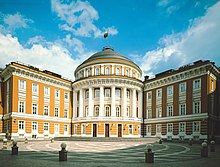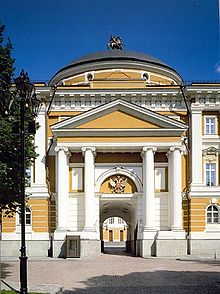Senate Palace
The Senate Palace ( Russian Сенатский дворец ) is a building in the Moscow Kremlin, built in 1787 . The Senate Palace is best known for the fact that in the early Soviet period it served as the residence of the heads of state and party leaders and the government, the Council of Ministers of the USSR , and is still the central office of the Russian President today.
general description
The Senate Palace is located in the northern part of the Kremlin grounds, where it is between the Arsenal and the former Building 14 . The outline of the palace has the shape of an isosceles triangle, one side of which is directly connected to the eastern Kremlin wall on the section between the Nicholas and Senate towers. This facade of the palace is visible from the other side of the wall, namely from Red Square . The other two sides - one facing the Arsenal and the other facing Building 14 - can only be seen from the Kremlin, with tourists not being able to get closer as the Senate Palace, as the official residence of the President, is strictly secured. The building can only be viewed and photographed from the opposite side of Ivan Square of the Kremlin (roughly at the height of the Tsar's cannon ). The southern corner facade of the Senate Palace is best visible from there.
history
The Senate Palace got its name from its original purpose as the headquarters of the so-called Governing Senate , which since its founding in 1711 under Peter I the Great was formally the highest supervisory body and legislative state organ of the Russian Empire . During the reign of Catherine II the Great in the 1770s, the ruling senate was divided into six departments, four of which were in the capital Saint Petersburg and two in Moscow . For these two, a representative building was to be built as the official residence in the heart of the city, namely in the Kremlin.
For the construction of the Senate Palace, a plot of land was made available in the north of the Kremlin grounds, on which previously some commercial buildings of the neighboring Chudov Monastery (which stood on the site of today's building 14 until 1930) and parts of private manors were located. The well-known city architect Matwei Kazakow , who had also participated in the reconstruction of the neighboring arsenal, was commissioned with the conception and execution of the work . So that the space available on the relatively cramped building site could be fully exploited, Kazakov chose a triangular floor plan for the building, with the longest side of this triangle facing the likewise elongated building of the arsenal. The construction work on the foundation walls lasted essentially from 1776 to 1787, while the interior fittings were partially worked on until 1790.
After its completion, the Senate building, which was mainly designed in the early classicist style, met with positive criticism, including from Catherine the Great, who personally praised Kazakov's work on the first visit. The building also served as an architectural model for several newly built administrative buildings in other Russian cities in the late 18th and early 19th centuries.
After three years of provisional use for Moscow aristocratic assemblies, the Senate Palace became the seat of two departments of the Governing Senate in 1790, according to its original purpose. As early as the early 19th century, after further reforms and restructuring measures within the Senate, it was no longer located in the Senate Palace. Instead, several state authorities were alternately housed there, including a department of the War Ministry, a renowned architecture school and, since 1866, the Moscow City Court. In this latter function, the Senate Palace was the scene of several spectacular trials, including the case of the industrialist Sawwa Mamontov in 1899.
After the October Revolution of 1917 and the move of the Soviet Russian government to the Kremlin in Moscow, the Senate Palace was used from then on as the seat of government and the venue for important conferences. In addition, in 1918 the revolutionary leader and head of state Lenin had an official apartment set up on the second floor of the Senate Palace, where he lived until 1923. After Lenin's death in 1924, the original furnishings in his former apartment and study were retained and converted into a museum, which was moved to Gorky Leninsky in Lenin's former suburban residence in the early 1990s .
Lenin's successor Josef Stalin also had an official apartment in the Senate Palace on the mezzanine floor. He was also the last Soviet or Russian head of state who not only worked in the Kremlin, but also lived.
From its founding in 1946 until the end of the Soviet Union in 1991, the Council of Ministers of the USSR had its headquarters in the Senate Palace. From 1992 to 1995 the entire building was extensively restored and set up as the official residence of the Russian President . Today the Senate Palace shares this function with the Grand Kremlin Palace , with both the study and the most important reception rooms of the President being located in the Senate Palace.
Architecture and interiors
Even if the Senate Palace is stylistically different from the two neighboring buildings, it gives the impression of a self-contained ensemble that it forms with the Arsenal and Building 14, not least because of the uniform golden-yellow facade color. At around 20 meters, the palace is almost the same height as the Arsenal and, with its triangular floor plan, has a similarly unconventional shape. In contrast to the arsenal building, which was designed for military purposes from the start, the architecture of the Senate Palace corresponds to the current standards for civil administration buildings. The three facades, each around 100 meters long, can be assigned to the early classicism that was widespread in Russia at the time . The palace has three floors, which can be recognized from the outside by the strictly geometric rows of windows that have additional ornamentation in the center of the facade at the "cut off" corners.
The central part of the building is the rotunda facing the Red Square , which is crowned by a mighty dome 27 meters high. This dome with the Russian national flag affixed to it can be clearly seen from Red Square, but not the lower part of the rotunda, which also houses the parade entrance. This can only be seen from the inner courtyard of the Senate Palace, which is closed to the public and surrounded by the building triangle. There is an arched passage in the middle of the facade facing the arsenal. This arch, above which a relief representation of the Russian double-headed eagle can be seen, is complemented by a four-column portico, which is closed at the top by a gable roof.
Inside the Senate Palace, the parade room known as the Katharinensaal ( Екатерининский зал ) is the most striking part of the building. Mainly important meetings and receptions are held here with the participation of the President. The circular hall with a diameter of 24.7 meters occupies the interior of the rotunda up to the dome and is particularly noticeable because of the row of columns in Corinthian order arranged along its entire circumference . With the rich high relief ornaments between the rows of windows - including several depictions of Catherine the Great as the goddess of wisdom Minerva - as well as the medallion images of Russian tsars and grand dukes, but also the magnificent chandeliers and the mosaic-like patterned parquet floor, the Catherine Hall of the Senate Palace is lavishly designed like the five parade halls of the Great Kremlin Palace (one of which is also called Catherine's Hall).
The three wings of the palace are connected to each other by a central corridor and two additional extensions that symmetrically divide the inner courtyard into a pentagonal central part and two side triangles. In addition to the usual office space of the President and his apparatus, they contain a number of other representative large rooms. Mention should be made here of the actual working cabinet of the president, also the presidential library (here, among other things, the representative copy of the Constitution of the Russian Federation is kept, on which the head of state swears the oath of office ), the parade hall of the president ( Представительский кабинет ) and Прететид the so-called coat of arms hall ( Гербовый зал ), in which foreign ambassadors are usually received.
Individual evidence
- ↑ nasledie.ru ( Memento of the original from January 8, 2007 in the Internet Archive ) Info: The archive link was inserted automatically and has not yet been checked. Please check the original and archive link according to the instructions and then remove this notice. (checked on January 24, 2009)
Web links
- Senate Palace. In: Structurae
- Senate Palace , kreml.ru (official Kremlin website, Russian)
- Description of the Senate Palace on the official website of the President of Russia ( memento of March 24, 2009 in the Internet Archive ) (Russian)
- Description in rusarh.ru (Russian)
Coordinates: 55 ° 45 ′ 11.5 " N , 37 ° 37 ′ 6.9" E




